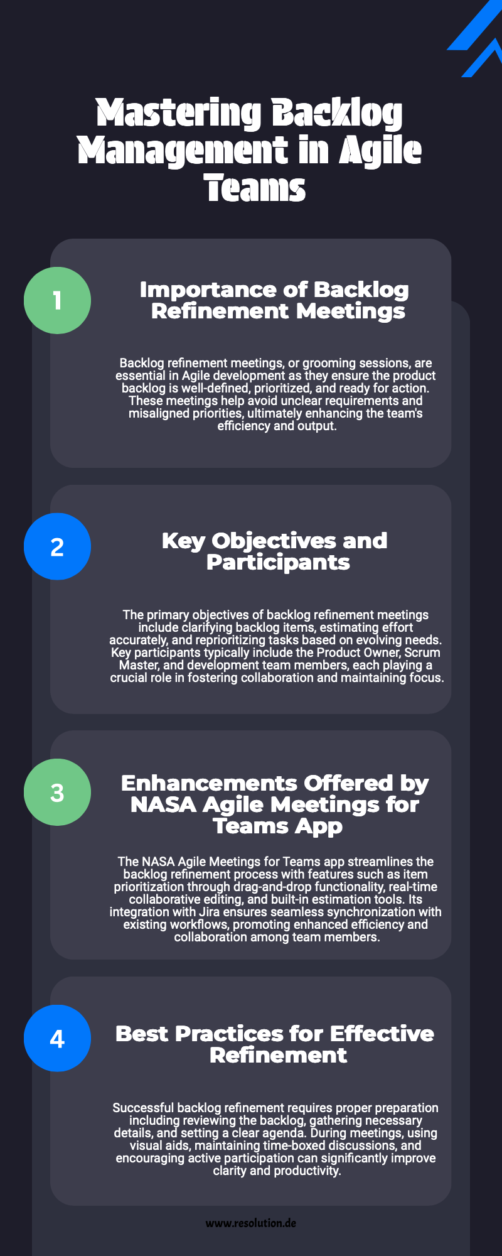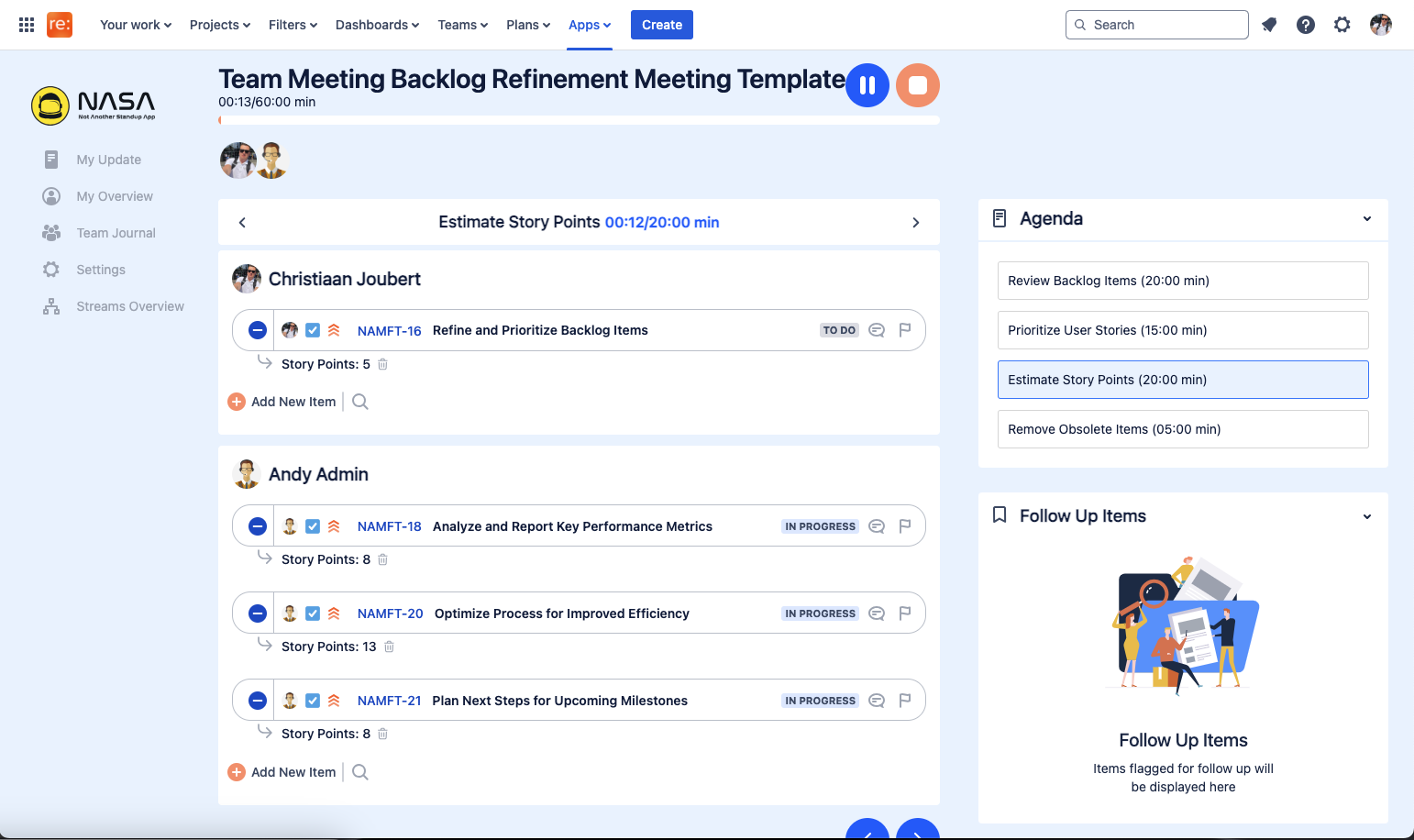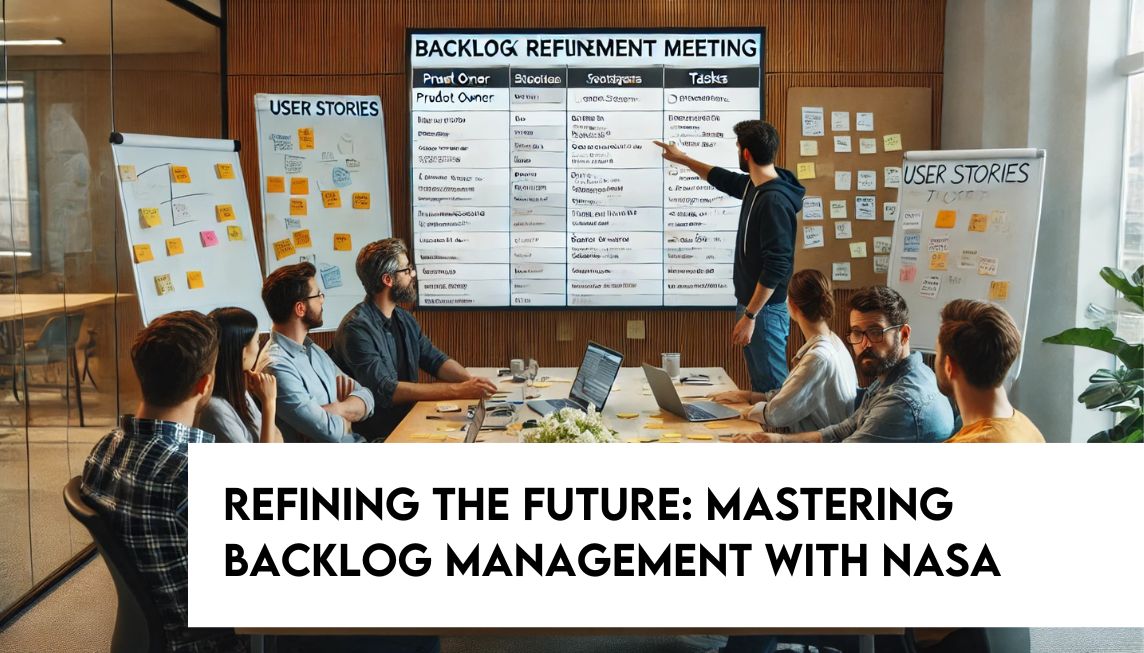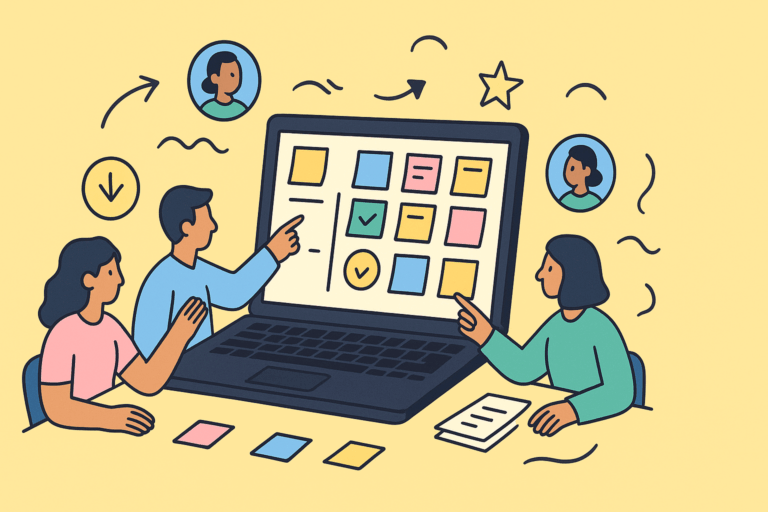In Agile development, backlog meetings are the bedrock of efficient project management and delivery. This ongoing process ensures the product backlog—the list of all work to be done—is updated, prioritized, & ready for action. By clarifying requirements and aligning priorities, teams can focus their energy on delivering the highest value to stakeholders.
Backlog meetings are essential for answering critical questions, such as what work is most important, how much effort tasks will take, and whether the team has the clarity needed to proceed. Without these regular sessions, Agile teams risk falling into misalignment, creating technical debt, or missing delivery goals.
Enter the NASA Agile Meetings for Teams app—a tool designed to take the chaos out of backlog meetings. This article explores the best practices for mastering agile backlog refinement and how this app empowers Agile teams to achieve their goals with efficiency and precision.
Key Takeaways
By the end of this article, you’ll understand:
The critical role backlog meetings play in Agile workflows.
The primary objectives and participants of these meetings.
Best practices for preparation & execution.
How the NASA Agile Meetings for Teams app simplifies & enhances backlog meetings.
Understanding Backlog Refinement Meetings
What Are Product Backlog Refinement Meetings?
Backlog meetings, also known as backlog grooming sessions, are collaborative discussions where the product backlog items are reviewed and updated. These meetings ensure the backlog items, such as user stories, tasks, and bugs, are:
Well-defined & detailed.
Properly prioritized.
Estimated for effort & feasibility.
Core Questions Addressed
What are the priorities? Determine which backlog items deliver the most value and align with current objectives.
Are items clear & actionable? Ensure each item has well-defined acceptance criteria.
What are the risks and dependencies? Identify potential blockers to development.
Are estimates accurate? Assign or adjust estimates to help with sprint planning.
The Collaborative Process
Backlog refinement is not a solo act. Key participants—Product Owners, Scrum Masters, and development teams—work together to make sure the backlog is clear, actionable, & valuable.
Importance of Backlog Refinement
Backlog refinement is the secret to maintaining an Agile team’s momentum. Without it, teams risk:
Unclear requirements: Leading to wasted time and rework.
Misaligned priorities: Causing delays in delivering value.
Overwhelming backlogs: Making it difficult to focus on what’s essential.
Example: Imagine a team members that skips refinement. They dive into a sprint only to find vague requirements, leading to frequent interruptions and missed deadlines.
Benefits of Effective Refinement
Clear direction: Every team member understands what’s expected.
Improved velocity: Less time is spent clarifying tasks during sprints.
Stakeholder satisfaction: Teams consistently deliver high-priority features.
Key Objectives of a Backlog Refinement Meeting
Clarifying backlog items: Ensure all items are well-understood.
Estimating effort: Use techniques like Planning Poker or T-shirt sizing.
Re-prioritizing tasks: Adjust based on changing needs and feedback.
Achieving these goals keeps your entire team focused and your backlog actionable, which is critical for smooth sprint planning.

Who Should Attend a Backlog Meetings?
Key Participants
Product Owner: Leads the discussion, clarifies requirements, and sets priorities.
Scrum Master: Facilitates the meeting to ensure it’s efficient and collaborative.
Development Team: Provides input on technical feasibility, risks, and effort estimates.
Collaboration is key. A well-attended meeting ensures no critical detail is overlooked.
Roles and Responsibilities
Product Owner: Prepares the agenda, prioritizes items, and clarifies business goals.
Scrum Master: Maintains focus, encourages participation, and resolves roadblocks.
Development Team: Shares insights on implementation, identifies dependencies, and estimates effort.
Each role plays a vital part in achieving a productive refinement session.
Preparation Steps
Preparation is half the battle in backlog refinement. Here’s a step-by-step guide:
Review the current backlog: Identify high-priority items for discussion.
Gather necessary details: Bring supporting documents or data for new items.
Prepare questions: Anticipate areas where the team might need clarity.
Set the agenda: Limit the scope to a manageable number of items.
How to Conduct an Effective Backlog Refinement Meeting
Step-by-Step Guide
Kickoff: Start with a clear agenda.
Review backlog items: Discuss details, clarify requirements, and ensure acceptance criteria are met.
Estimate effort: Use collaborative tools to agree on estimates.
Re-prioritize tasks: Adjust based on business needs and team capacity.
Summarize outcomes: Document decisions and next steps.
Tips for Success:
Use visual aids like Kanban boards or user story maps.
Time-box discussions to avoid dwelling on minor details.
Encourage active participation from all attendees.
How NASA Agile Meetings for Teams Enhances Backlog Refinement
The NASA Agile Meetings for Teams app transforms backlog refinement into a seamless process. Here’s how:
Key Features
Item Prioritization: Drag-and-drop functionality to rank tasks effortlessly.
Collaborative Editing: Real-time updates ensure everyone stays aligned.
Estimation Tools: Built-in support for Planning Poker and effort estimation.
Integration with Jira: Syncs directly with your existing workflows.
Benefits
Improved Efficiency: Automation reduces manual effort.
Enhanced Collaboration: Remote and hybrid teams can work together seamlessly.
Clearer Insights: Visualization tools provide clarity on priorities and dependencies.
Example Use Case: A distributed Agile team uses the app to conduct a refinement session. Thanks to its Jira integration and collaborative editing features, they align on priorities in record time, despite being in different time zones.

Summary
Backlog refinement is an essential practice for teams. By following best practices—preparing effectively, fostering collaboration, and focusing on clear objectives—you can ensure your team is always sprint-ready. The NASA Agile Meetings for Teams app takes this process to the next level, offering powerful tools for prioritization, collaboration, and integration.
Ready to elevate your backlog refinement meetings?
Schedule a demo today to see the NASA Agile Meetings for Teams app in action.
Visit our product page for more details.
Download the app now from the Atlassian Marketplace and start refining with confidence.
Master your backlog, empower your team, and deliver value consistently with the help of the NASA Agile Meetings for Teams app!
Frequently Asked Questions
What is backlog refinement?
Backlog refinement is the process of reviewing and updating the product backlog to ensure it is clear, prioritized, & actionable.
How often should backlog refinement meetings occur?
These meetings should occur regularly, typically once a week, or as needed based on the team’s sprint cadence.
How long should a backlog refinement meeting last?
Generally, these meetings should be time-boxed to 60-90 minutes to maintain focus and productivity.
What tools can help with backlog refinement?
Tools like the NASA Agile Meetings for Teams app, Jira, and Miro streamline the process with prioritization frameworks, collaboration features, and integration capabilities.
By applying these insights & leveraging the right tools, you can make backlog refinement a strength rather than a struggle.
Understanding What Product Backlog Refinement Is and Its Importance
What is Product Backlog Refinement?
Product backlog refinement is an ongoing process in Agile development where the product owner and development team collaborate to ensure the product backlog is understood, sized, and prioritized.
The goal is to create a shared understanding of what the product will and won’t do, the effort required to implement it, and the order in which it will be done.
Backlog refinement is also known as backlog grooming, but the term “refinement” is now more commonly used.
Benefits of Product Backlog Refinement
Backlog refinement improves the efficiency of sprint planning, keeps the product backlog (and product owner) focused, clean, and relevant, and leverages collaboration in detailing user stories and defects.
It helps the product owner identify which tickets add the most business value and which are superfluous.
Regularly refining the product backlog makes sprint planning easier by providing a clear understanding of the tasks and their context.
Backlog Refinement vs. Backlog Grooming
Backlog refinement and backlog grooming mean the same thing, but the term “refinement” is now more commonly used to avoid the negative connotation of “grooming”.
Both terms refer to the process of reviewing and prioritizing product backlog items.
Who Should Attend a Backlog Refinement Meeting?
The product owner, development team members, and other relevant stakeholders should attend a backlog refinement meeting.
The Scrum Master may also facilitate the meeting to ensure effective communication and keep the session focused.
How to Run an Efficient Backlog Refinement Meeting
Assemble the right people, including the product owner, development team members, and other relevant stakeholders.
Set expectations and create a meeting agenda to keep discussions on topic.
Prioritize and evaluate items, and define the next steps.
Use a definition of ready (DoR) to ensure the team understands what the work entails and can estimate the time needed for it to get done.
Tips for Successful Backlog Refinement
Keep the backlog DEEP (detailed, emergent, estimated, and prioritized).
Use a shared understanding of how the backlog works to align expectations.
Regularly refine the product backlog to ensure it remains relevant and up-to-date.
Break down complex items into smaller, more manageable tasks.
Avoid forced decisions and keep the backlog dynamic.
Frequency and Duration of Backlog Refinement Sessions
Backlog refinement is an ongoing process that occurs throughout the project lifecycle.
Most teams schedule formal sessions once per sprint, dedicating 5-10% of sprint time to refinement.
The frequency and duration of backlog refinement sessions may vary depending on the team’s sprint cycle and project complexity.
Activities within the Backlog Refinement Process
Product discovery, both initially and on an ongoing basis.
Identifying and removing items that sounded good but are no longer relevant.
Improving clarity and preventing misunderstanding by adding details in preparation of implementation.
Sizing items, including re-sizing them.
Prioritizing items, and re-prioritizing them when you add more details or gain new insights.
Best Practices for Product Backlog Management
Foster open communication between the product owner, development team, and Scrum Master.
Prioritize based on customer and project value.
Estimate with confidence using techniques like planning poker.
Keep task dependencies in mind and clearly label them to avoid accidental task start.
Conclusion
Product backlog refinement is a crucial process in Agile development that ensures the product backlog is understood, sized, and prioritized.
By following best practices and tips for successful backlog refinement process, teams can improve the efficiency of sprint planning, keep the product backlog focused and relevant, and deliver high-quality products that meet customer needs.




